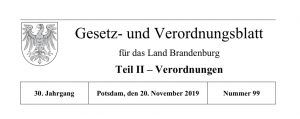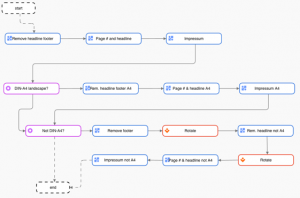
Digital publication of regulations and laws in Brandenburg (Germany)
Already in 2009, the German state Brandenburg started to publish all laws digitally and uses – no surprise – PDF for that. It still is (at least) a nationwide pioneer. In this blog, I want to explain the requirements which are sometimes completely different from for e.g. publishing magazine articles online but also sometimes surprisingly close even to print publishing.
Already in 2009, the German state Brandenburg started to publish all laws digitally and uses – no surprise - PDF for that. It still is (at least) a nationwide pioneer. In this blog, I want to explain the requirements which are sometimes completely different from for e.g. publishing magazine articles online but also sometimes surprisingly close even to print publishing.
Publication (promulgation) of laws and regulations
The classic, paper-based publication of laws and regulations deals with two documents: The original, which is signed by one or more ministers and archived for long-term and the document, which is published (promulgated) officially in a dedicated publication, in Brandenburg the “Gesetz- und Verordnungsblatt (GVBI)”.
The high-level procedure for digital publication is not very different and also creates two documents: the physical signatures on the archived copy are replaced by qualified electronic signatures and the published (promulgated) document is also digitally signed by the issuing authority.
As we will see the most problematic requirement is that the two documents have to be identical in content – even down to the line breaks – but that on the other hand, headers and footers are different on page and on document level. The only way to achieve this is to use the same source PDF for both which is then formatted in two different ways.
PDF based standards
Document requirements for laws and regulations are obviously high and this applies to quality as well as to feature richness. Long-term suitability is as indispensable for archival as reliable rendering and accessibility is for the promulgated documents. For PDF this can be maintained using related ISO standards: PDF/UA and PDF/A are mandatory.
Additional requirements are related to the fact that some regulations may contain scanned maps e.g. road construction plans. In order to make sure that such regulations are available to everybody in the state, all promulgated documents are to be printed and made available in local courts. And that adds PDF/X.
Compliance with PDF/UA, PDF/A and PDF/X of a single document is not extremely complex to achieve https://www.callassoftware.com/en/blog) but there are challenges below the high-level processes described above.
PDF/UA (Tagging) and PDF/A
The generation of correct tags for PDF publication always starts in the source program, here e.g. MS Word. A tricky requirement results from the (little known) fact that the state Brandenburg has the obligation to consider the language of a minority, Lower Sorbian. In the tagging structure of the documents, the language change must therefore be defined correctly in the correct places.
From a PDF point of view, the main requirement here is to check the tagging structure, a task which - according to PDF/UA - cannot be completely automated, but for which e.g. callas pdfGoHTML or other free tools are available.
The result of this process is the source PDF, compatible with PDF/UA, PDF/A and PDF/X, which then has to be converted for the two variants that are needed.
Formatting and signing
The most complex requirements from a PDF point of view arose - somewhat surprisingly - during formatting, because – as mentioned before - the documents for archival and promulgation have to be identical in their core content but have to vary in additional content parts. Of course, any errors have to be avoided and therefore this formatting runs automatically via a Profile in pdfaPilot.

The promulgated version has a document header with the Brandenburg coat of arms, headers on each page and an imprint on the last page. In addition, the pages are provided with consecutive page numbers, even if the PDFs are merged from several original documents. Since the page and line breaks must be absolutely identical in the archival and promulgation documents, the source file must already provide sufficient white areas. E.g. if an imprint is needed on the last page, the page break must be made in a way that the free area is large enough.
A further complexity dimension results from the fact that input documents can be in portrait or landscape format and even – when they contain maps – in arbitrary page sizes.
What had to be created is a complex set of rules for all possible input formats with steps for automated removal of headers and footers, addition of other content such as the imprint, merging of documents and creation of new pages. This has been built as a Process Plan:

Process plan GVBI
Once the formatting has been completed, both documents are signed with a qualified electronic signature – of course in a manual step – and we have a new law or other regulation here:
https://www.landesrecht.brandenburg.de/dislservice/public/gvbl.jsp
(Post title image source: https://verfassungsgericht.brandenburg.de/verfgbbg/de
callas software finds simple ways to handle complex PDF challenges. As a technology innovator, callas software develops and markets PDF technology for publishing, print production, document exchange and document archiving. callas software helps agencies, publishing companies and printers to meet the challenges they face by providing software to preflight, correct…
Read more




